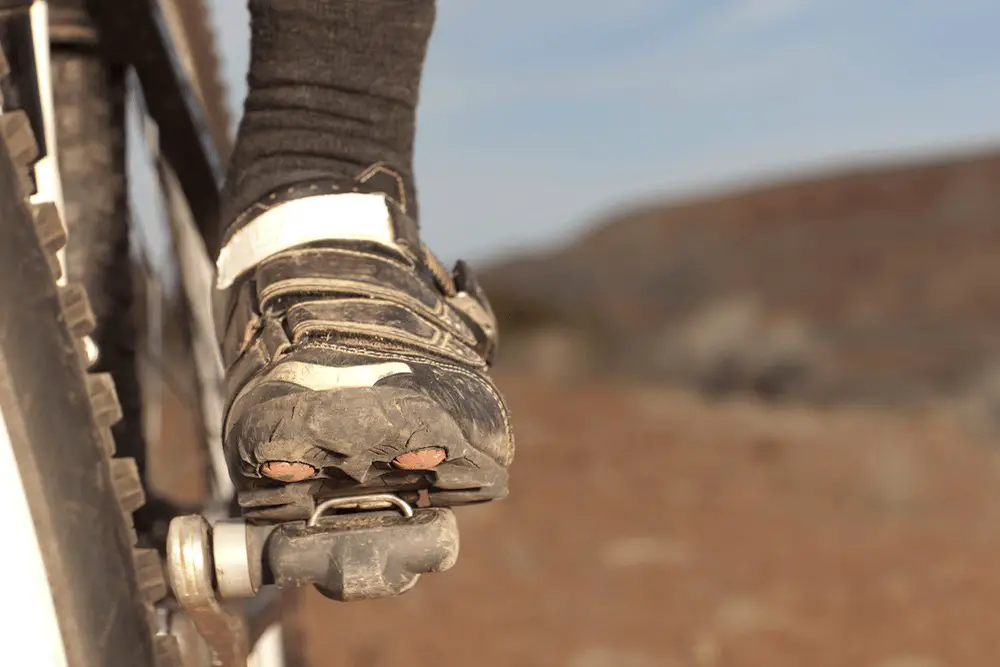
Choosing the best shoe for mountain biking is just as hard – and important – as choosing the perfect bike. When biking, your feet do most of the work, and they are the most important points of contact between you and your bike.
At A Glance: Our Top 5 Picks for Mountain Bike Shoes
- MOST COMFORTABLE: Giro Empire VR90
- MOST DURABLE: Five Ten Freerider Pro
- MOST FLEXIBLE: Pearl Izumi X-Project Pro
- Fizik’s Terra X5 Suede
- Giro Jacket II
Top 5 Best Mountain Bike Shoes (Summary)
For more detailed and complete product reviews on benefits and features, keep reading.
So, of course, what you wear on your feet really matters. When biking it is important to purchase the right shoe for your type of riding. There is not a “perfect” shoe for every rider, so below we will go through the pros and cons of a few popular choices to help you sort everything out.
6 Best Mountain Bike Shoes
1. Giro Empire VR90
The Giro Empire VR90s have been rated one of the best clipless mountain bike shoes over and over again. One of its most exciting features is the customizable insoles, giving you the perfect arch for the most comfortable fit.
They are resilient to wear and tear and are some of the highest rated because of their durability in high-performance, off-road rides. They are extremely lightweight which ends up giving them a little less protection on the sides, so extremely aggressive trail riders should take note of that.
They are made with Vibram rubber outsoles which allow for a strong grip on the trails during short treks with your bike. The rubber soles are fairly stiff which is particularly helpful during riding, giving you amazing power transfer onto the pedals.
Check Price and Rating on Amazon.com
Pros
- Extremely comfortable
- Lightweight
- Strong grip with Vibram rubber sole
Cons
- Less protection on sides
- Takes more time to lace them up
- Expensive
2. Five Ten Freerider Pro
Five Ten is one of the most popular flat-pedal shoe brands on the market, and for good reason. Their rubber technologies provide glue-like traction with pedals, and they are some of the best you can get for general trail riding.
Five Ten’s Stealth S1 rubber has been added to the toe box, giving you extra protection in one of the main spots that debris and rocks will hit. They are a bit stiffer than some of the other flat-pedal shoes, which means better power transfer but less support when hiking.
Check Price and Rating on Amazon.com
Pros
- Extra protection on toe box
- Extremely durable
- Good for multiple types of riding and weather
- Well ventilated
Cons
- Not as flexible when walking as other flat-pedal shoes
- Low-cut, giving no ankle protection
3. Pearl Izumi X-Project Pro
Sporting a Boa retention system, grippy rubber outsole, stiff carbon sole, and customizable insole, the Pearl Izumi X-Project Pros are some of the best mountain bike shoes you can buy. They are on the expensive side, but once you ride with them you will understand why they have been picked as a top shoe so many times.
The X-Project PRO is Pearl Izumi’s top-of-the-line mountain bike shoe. They have a stiff carbon sole like most clipless shoes, but the toe allows for extra flexibility. This means you get to keep all of the power from a stiff shoe without sacrificing any of the walkability when off the bike.
These shoes hold up well through all mountain biking styles and conditions, even surpassing a lot of shoes made specifically for rough riding. The Boa retention system makes for easy fitting without having to hassle with laces and the sticky rubber grip allows easy walking, even when trails are wet.
Check Price and Rating on Amazon.com
Pros
- Good for different styles of mountain biking
- Boa retention system on the top of the shoe, causing less chance of being hit and broken
- Carbon sole does not extend to toe offering more flexibility when walking
- Replaceable parts
Cons
- Expensive
4. Shimano ME7
One of the highlights of Shimano’s ME7s is their speed lacing system. Instead of laces they have a drawstring that cinches down and secures with a ratchet buckle. A large Velcro strap covers the top of the drawstrings, providing extra protection from mud and grit.
The ME7s are extremely well ventilated, making for a great summer shoe. They have a stretchy cuff made from perforated material to keep trail debris out, while still allowing for airflow. The materials used are very lightweight without sacrificing on durability. The cuff is perfect when riding through dry, dusty trails.
They hold up great during intense mountain biking, even when riding through wet trails. The material is mesh so they are not waterproof, but their light inside padding allows water to easily escape and dry out.
Check Price and Rating on Amazon.com
Pros
- Stretchy ankle cuff to keep out dust and debris
- Good performance on wet trails
- Extremely comfortable
Cons
- Get warm on really hot days
- Sole not as stiff as other brands
5. FizikTerra X5 Suede
Fizik’s Terra X5 shoe can either come in suede or microtex material. The suede version offers riders a shoe made with natural materials instead of synthetics. The natural material is good for water resistance, stretch, and breathability. The suede also holds up better to damage that could incur from the trails.
The X5s have a Boa retention system and Velcro strap near the toe, giving you the best fit possible. The sole offers a good balance between pedaling efficiency and off-the-bike walkability, allowing them to be used for multiple types of riding.
They have a good ventilation system – ontop of using the natural suede – so temperature regulation is not a problem. The Terra X5 Suede shoes are some of the most comfortable mountain biking shoes you will be able to find.
Check Price and Rating on Amazon.com
Pros
- Natural materials
- Great temperature regulation
- Extremely comfortable
- Stylish
Cons
- Boa dial on the side can get caught on obstacles
- Toe strap doesn’t make much difference in fit
- A little stiff for walking
6. Giro Jacket II
The Giro Jacket II is a flat pedal shoe that looks a lot like a skate shoe. They are made for biking, but they are so comfortable and easy to walk in that you can wear them during other activities. They sport a top-of-the-line Vibram rubber outsole, giving them amazing grip whether you are biking or hiking through trails.
The Jacket IIs have a midsole made with Poron XRD, which is a soft, shock-absorbing material. It blocks about 90% of impact to your feet without sacrificing power transfer or performance. Relieving stress from your feet makes it much easier to go on long rides or to cycle through rough trails. If you are looking for a flat-pedal shoe that is comfortable to ride in all day long, these are the perfect choice for you.
Check Price and Rating on Amazon.com
Pros
- Great for using off-bike
- Shock-absorbing midsole to relieve stress on feet
- Highcomfort for long rides
Cons
- Not as flexible as other flat-pedal shoes
- Velcro strap on top is a bit short
Types of Mountain Bike Shoes
Everything You Need to Consider Before Buying
1. Your Pedals
One of the first choices you will make as a rider is whether you are going to use flat-pedals or cliplesspedals. There are pros and cons for each option and a lot of it boils down to what type of riding you are going to be doing.
If you are just breaking into the sport and don’t want to drop a bunch of money on a new pair of shoes, flat-pedals will be your best friend. These pedals are designed to help increase traction with your shoe by using a series of pins on a large platform. Most any tennis shoe will work with these pedals, giving you time to decide on your ideal pair.
The name “clipless pedals” is a bit confusing because these pedals actually DO clip to cleats on your shoes. When mountain biking first became a sport, the pedals had a toe clip in the front, which consisted of a cage and strap. Looking for a way to lose the bulkiness while still keeping the pedaling efficiency, Shimano created the first “clipless” pedal.
One of the major benefits of using clipless pedals is that you always know your foot is in the best spot possible for riding. The pedals clip in to cleats that are positioned right under the ball of your foot, allowing for the most efficient energy transfer while riding.
2. Flat-Pedal Shoes
Although most riders prefer clipless shoes, flat-pedal shoes definitely have some advantages when doing certain types of riding, especially for beginners. Besides the benefit of being able to use a wide variety of different tennis shoes, flat-pedal shoes allow riders to get a feel for basic riding techniques before being attached to the bike. Since there is usually some falling, it allows the rider to ditch the bike quickly, without the stress of detaching from the pedals.
Flat-pedal shoes are usually made of a sticky, rubber outsole which provides greater grip and stability with the pedals. They have lugs on the outsole which connect with the pedal better than a normal flat-bottomed shoe would, so buying a specific mountain bike shoe is recommended.
The rubber soles also help with traction when walking over rocks and roots through different trails. If your shoe has stiff, plastic lugs then trekking through uneven grounds will be harder because your shoe wont bend around the obstacles. Flat-pedal shoes offer greater protection to the sides and bottoms of your feet, making them great shoes for riding through rough trails, downhill, or if you plan on doing a lot of walking.
Shoes with a plastic outsole and lugs tend to be cheaper, but they do not provide the same support as ones made with rubber or fiberglass variants. Since your feet are not clipped to the pedal, you need to make sure to get a shoe that will provide you with the best traction and grip possible.
3. Clipless Shoes
The majority of mountain bikers go for clipless shoes. These shoes connect your shoe to the pedal using a cleat, which will allow for extremely good control over your balance and speed. With the shoes being connected to the pedal it means you are not only pushing down on the pedal, but also pulling up, giving you more power out of each pedal stroke.
A big part of mountain biking is learning how to connect with your bike, and clipless pedal shoes allow for that in the best way. Your feet being attached allows you to manipulate your bike over obstacles easier, enhancing your stability and confidence as a rider.
The soles on clipless pedals tend to be much stiffer than regular tennis shoes, making them impractical for doing much else besides biking. This could be seen as a downfall, but in reality, it means that you are not wearing down your expensive shoes doing random activities. The shoes last longer when they are only being used for their purpose, allowing you to get the most out of your purchase.
Since clipless shoes are the preferred type among riders, there are a lot more options when it comes to buying. This makes it extremely easy to find a good pair that not only fits your needs, but also your fashion sense.
4. Performance Comfort & Fit
Most of your effort in mountain biking is transferred through your feet, so making sure you have a pair of shoes that will be comfortable is extremely important. When figuring out how comfortable your shoes will be you want to look at not just the fit, but also the breathability and cushioning.
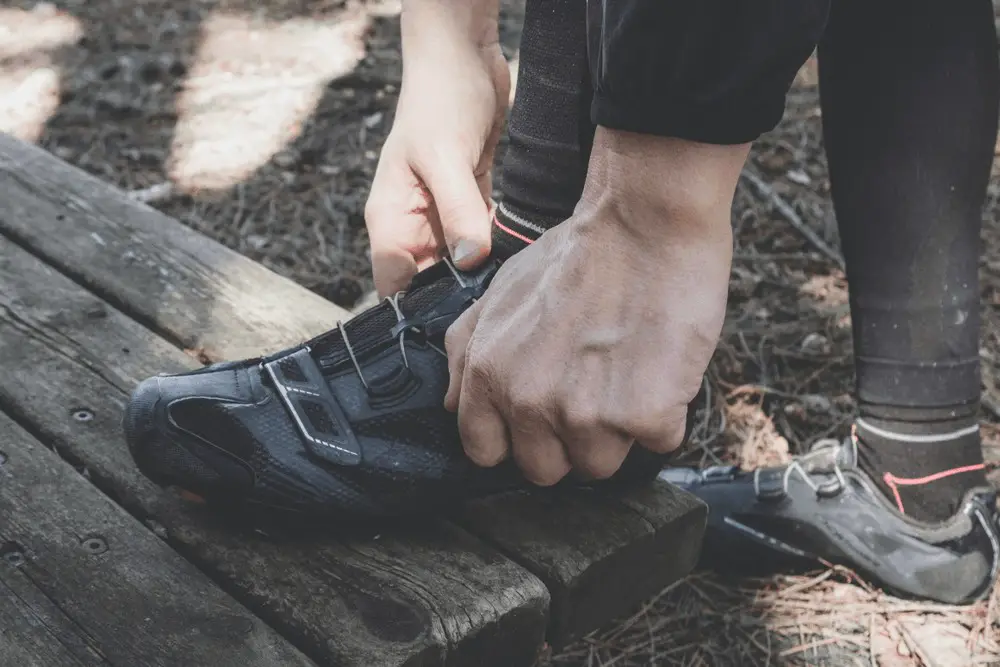
The outsole of your shoe is important when figuring out the amount of protection you need from the elements, but the insole is what is important when it comes to finding a comfortable shoe. Cushioning is what stops you from feeling every bump and gives you a smooth ride through rough trails.
If you are buying your first pair of mountain biking shoes the best route would be to try some on in person. For the best fitting, wear the sock you will wear riding and walk around the store a lot. Pay attention to any seams rubbing, pressure points, or lifting as you walk. Just because a shoe is expensive, or considered the best, doesn’t mean they will be the best for you. Any discomfort in the store will be amplified when riding through the trails, so don’t settle!
If you do decide to buy your first pair online, make sure you pay close attention to sizing. Every professional site has a size guide which will show you how to measure your foot. Measure the width as well as the length, as many shoes offer a variety of widths. If your shoes do not fit right then riding will be even more stressful for your feet, making for a long day of riding.
5. Weather Proof & Toughness
Having the right shoe for weather conditions can end up being the difference between riding through the trail or getting off your bike. When it comes to the weather, price and quality don’t matter as much as making sure your shoe is properly equipped to handle the environment.
This is even more important when you are riding with flat-pedal shoes. If you do not have enough traction with your pedal and shoe, even a light rain can cause major slipping and can ruin your ride.

Waterproof shoes could be a good idea if you live in an area with a lot of rainfall, but they are not always the right answer. The shoes are sealed on the top and are made with material that does not allow for leakage. Moisture cannot get in – perfect for muddy trails – but moisture also cannot escape. If you are going with waterproof shoes, make sure they have a breathing membrane which will allow air to flow.
Since most mountain biking happens during warm weather, shoe companies cater to their riders having well-ventilated shoes. After all, a sweaty, moisture-ridden foot will make for a heavy shoe and an uncomfortable ride. Most shoes highlight their lightweight material and their ventilation systems that keep your feet as cool as possible. This is great…unless you are wanting to ride in the winter. Good ventilation can quickly become a danger in cold climates.
If the winter is not too extreme, shoe covers could be enough to protect your feet. They block wind, moisture, and some even have insulation. The downfall is that they still require a hole where the cleat attaches. Since the cleats are created as an extreme ventilation system – drawing the heat away from your foot and down into the pedal – all they do is let out the warm air that builds up inside your shoe cover.
Some companies make winter-specific shoes for both flat-pedals and clipless. If you plan on riding in cold temperatures a lot, these would definitely be worth looking in to. Riding in the winter with shoes that are not equipped to handle the cold is NEVER a good idea.
6. Shoe Weight
It may not seem like shoe weight really matters – we are talking the difference between just a few grams here – however, shoe weight makes a HUGE difference. There is a reason why there is such a broad range of prices when it comes to mountain bike shoes, and it isn’t just a brand-name thing.
Lightweight shoes reflect on the type of material that is being used. Shoes that use too light of a material end up being more susceptible to external damage. Some of these are okay for road biking, but when mountain biking you have to not only pay attention to the weight, but also to the functionality of the material.
The best brands will give you the lightest weight without sacrificing durability. When looking at materials, avoid shoes made with traditional rubber. It is a bulky material and most professional brands have switched to fiberglass variants and synthetic rubbers. For clipless pedal shoes, look for something made with carbon fiber instead of a nylon shank.
When riding for a long time, even the difference between a few grams can end up effecting your ride. Lightweight shoes offer more comfort and maneuverability, allowing your feet to work harder for longer.
7. Retention System
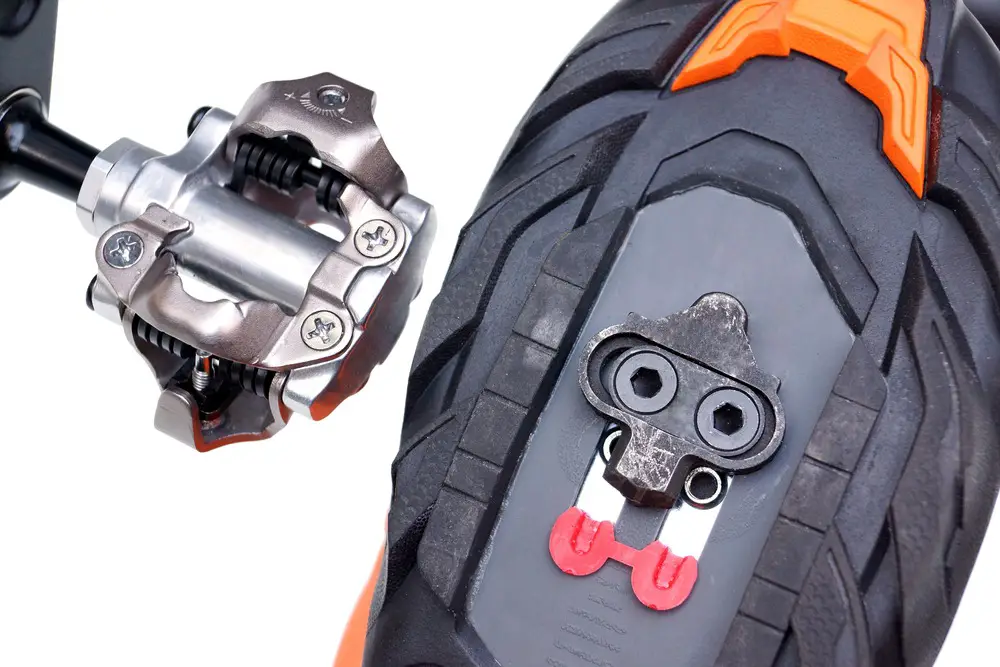
Retention systems can make a big impact on the weight – and price – of your shoe. The traditional system would be laced, and most flat-pedal shoes stick to that. They are a tried-and-true method that work well but they are not necessarily the best option. They cannot easily be adjusted when riding, and they can get clogged up with mud.
One answer to the problem with laces is a lace flap. This is simply, exactly what it sounds like: a flap to cover your laces with. It will protect them from possibly getting caught on something, mud and debris sticking to them, and it will keep them tight.
Cheaper shoes often use a ratchet buckle closure or Velcro straps. These weight more, so for more serious riding, bikers usually upgrade to a shoe without these systems. Velcro also becomes unreliable when it is wet, slipping out of place and making for a loose fit.
The top brands usually offer a Boa retention system on their shoes. This is made up of a ratchet dial and wire-like laces that allow for easy closure and adjustments. Some shoes – like Pearl Izumi’s X-Project Pro – have Boa dials in the middle of the tongue, giving the best and most comfortable fit possible.
If you are worried about the weight of your shoe, the Boa retention system is definitely the best option on the market right now. They are lightweight but durable, and if anything is to happen they are easily replaceable.
So Basically
All of that information boils down to just one major question; what type of riding are you going to be doing? If you know the type of trails you will be on, how much walking you will be doing, and the weather for most of your rides, you will be able to make an informed choice on the shoe that will be best for you.
You don’t need to spend $400 to get a good pair of shoes, you just have to know what you’re looking for. That $400 pair could, in fact, be completely wrong for your type of riding; balance the cost with what you will need in your shoe.
When it comes to picking the perfect mountain bike shoe, just don’t stress! There are a lot of really good options for every type of riding.
We Get This All the Time…FAQ’s
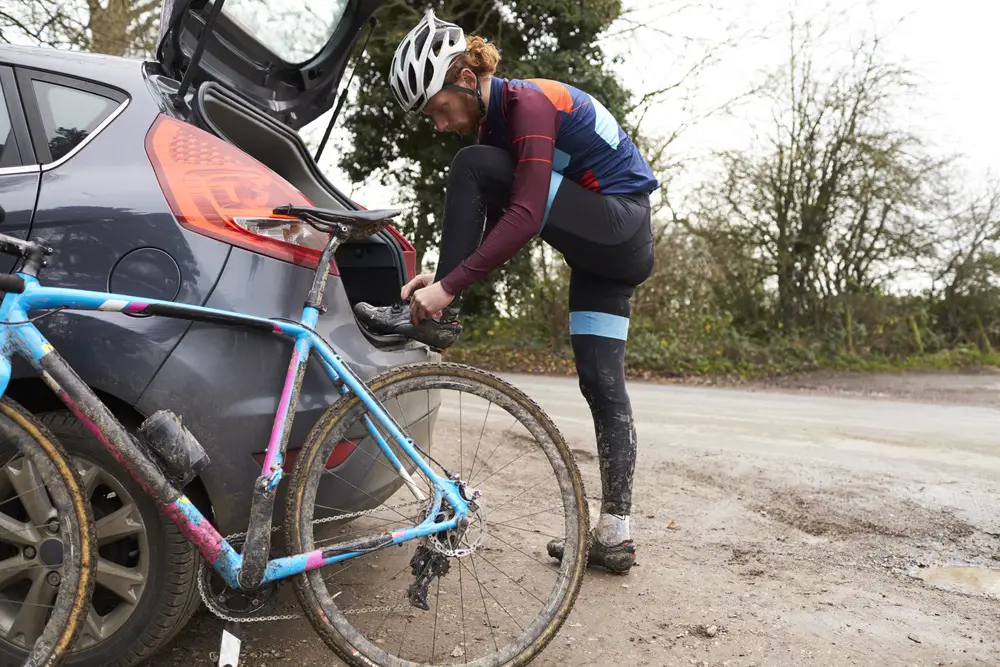
Q: How do I know if my shoe fits right?
I’m sure you have heard the term, “breaking-in” your shoes. While this is true, it is only to a certain extent. When trying on a new pair of shoes, they will be stiffer than they will be after a few rides, but they should still feel comfortable. If you walk around and your shoes are lifting, rubbing, feel too tight or too loose, or are just generally uncomfortable: don’t try to wear them riding! Mountain biking shoes come in a huge variety of sizes and styles, it is unnecessary to make your feet suffer through your rides.
Q: Is there a safe way to buy a shoe that fits online?
When buying your first pair of mountain biking shoes it is recommended that you visit a shop to get a feel for what type of shoe you prefer. This allows you to walk around in them and get a feel for the shoe before you buy.
If you do decide to buy online, pay attention to the width measurements as well as the length. Mountain biking shoes should fit snuggly, without being too tight, so most professional brands offer a wide variety of sizes.
It is also good to look for a brand that allows for free return shipping and size exchanges. If you order a pair that doesn’t fit right, you can exchange with no hassle.
Q: Can I use them for other activities or are they strictly for biking?
In general, if you buy a pair of mountain biking shoes it is best to keep them exclusively for biking. They are made specifically for pedaling – not walking – so wearing them around would be uncomfortable and could cause damage to the shoe.
Flat-pedal shoes are more versatile than clipless shoes. Some of them are made for trekking through trails in areas where you have to get off your bike, so they have outsoles that protect against the elements. If you are planning on doing a lot of walking with your riding, then look for a pair with a sticky outsole that is not too stiff.
Q: How do I clean my shoes?
Brushing off your shoes after every ride should be enough cleaning most of the time. If they are really dirty, or caked with mud, let them sit in warm water for 10-15 minutes before brushing them off.
If your shoes have a removable insole, remove them while letting them dry. If the insole is not removable then you can pack newspaper inside the shoe to absorb the moisture.



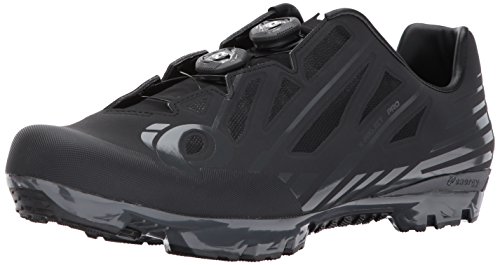



I never heard of the newspaper idea. How long does it take to dry? If you don’t have newspaper laying around what other methods do you recommend to drying out your shoes?